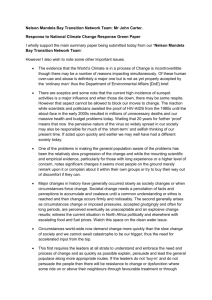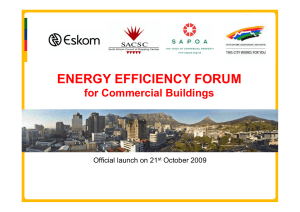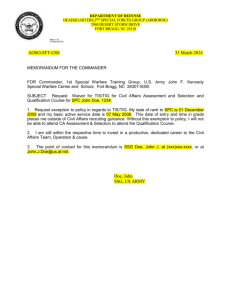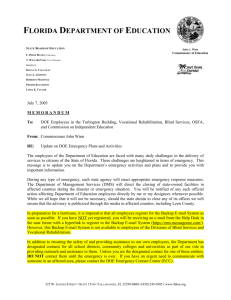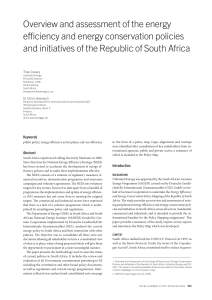SUPREME LAW POLICY AND STRATEGY
advertisement
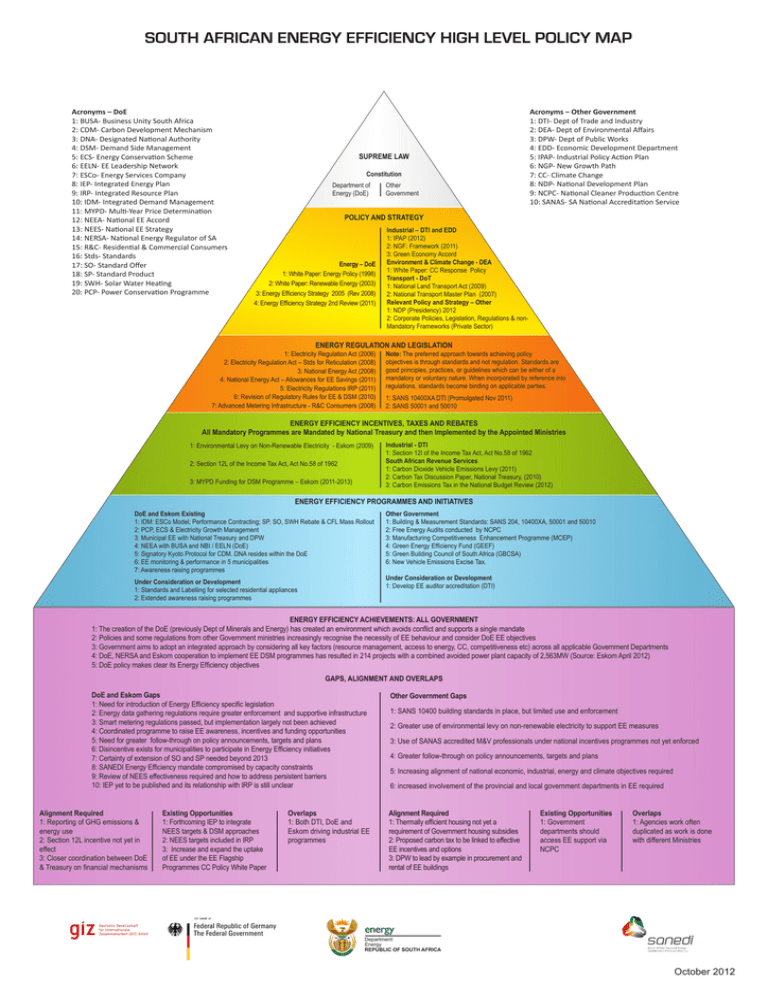
SOUTH AFRICAN ENERGY EFFICIENCY HIGH LEVEL POLICY MAP Acronyms – DoE 1: BUSA- Business Unity South Africa 2: CDM- Carbon Development Mechanism 3: DNA- Designated National Authority 4: DSM- Demand Side Management 5: ECS- Energy Conservation Scheme 6: EELN- EE Leadership Network 7: ESCo- Energy Services Company 8: IEP- Integrated Energy Plan 9: IRP- Integrated Resource Plan 10: IDM- Integrated Demand Management 11: MYPD- Multi-Year Price Determination 12: NEEA- National EE Accord 13: NEES- National EE Strategy 14: NERSA- National Energy Regulator of SA 15: R&C- Residential & Commercial Consumers 16: Stds- Standards 17: SO- Standard Offer 18: SP- Standard Product 19: SWH- Solar Water Heating 20: PCP- Power Conservation Programme SUPREME LAW Constitution Department of Energy (DoE) Other Government Acronyms – Other Government 1: DTI- Dept of Trade and Industry 2: DEA- Dept of Environmental Affairs 3: DPW- Dept of Public Works 4: EDD- Economic Development Department 5: IPAP- Industrial Policy Action Plan 6: NGP- New Growth Path 7: CC- Climate Change 8: NDP- National Development Plan 9: NCPC- National Cleaner Production Centre 10: SANAS- SA National Accreditation Service POLICY AND STRATEGY Energy – DoE 1: White Paper: Energy Policy (1998) 2: White Paper: Renewable Energy (2003) 3: Energy Efficiency Strategy 2005 (Rev 2008) 4: Energy Efficiency Strategy 2nd Review (2011) Industrial – DTI and EDD 1: IPAP (2012) 2: NGF: Framework (2011) 3: Green Economy Accord Environment & Climate Change - DEA 1: White Paper: CC Response Policy Transport - DoT 1: National Land Transport Act (2009) 2: National Transport Master Plan (2007) Relevant Policy and Strategy – Other 1: NDP (Presidency) 2012 2: Corporate Policies, Legislation, Regulations & nonMandatory Frameworks (Private Sector) ENERGY REGULATION AND LEGISLATION 1: Electricity Regulation Act (2006) 2: Electricity Regulation Act – Stds for Reticulation (2008) 3: National Energy Act (2008) 4: National Energy Act – Allowances for EE Savings (2011) 5: Electricity Regulations IRP (2011) 6: Revision of Regulatory Rules for EE & DSM (2010) 7: Advanced Metering Infrastructure - R&C Consumers (2008) Note: The preferred approach towards achieving policy objectives is through standards and not regulation. Standards are good principles, practices, or guidelines which can be either of a mandatory or voluntary nature. When incorporated by reference into regulations, standards become binding on applicable parties. 1: SANS 10400XA DTI (Promulgated Nov 2011) 2: SANS 50001 and 50010 ENERGY EFFICIENCY INCENTIVES, TAXES AND REBATES All Mandatory Programmes are Mandated by National Treasury and then Implemented by the Appointed Ministries 1: Environmental Levy on Non-Renewable Electricity - Eskom (2009) 2: Section 12L of the Income Tax Act, Act No.58 of 1962 3: MYPD Funding for DSM Programme – Eskom (2011-2013) Industrial - DTI 1: Section 12I of the Income Tax Act, Act No.58 of 1962 South African Revenue Services 1: Carbon Dioxide Vehicle Emissions Levy (2011) 2: Carbon Tax Discussion Paper, National Treasury, (2010) 3: Carbon Emissions Tax in the National Budget Review (2012) ENERGY EFFICIENCY PROGRAMMES AND INITIATIVES DoE and Eskom Existing 1: IDM: ESCo Model; Performance Contracting; SP, SO, SWH Rebate & CFL Mass Rollout 2: PCP, ECS & Electricity Growth Management 3: Municipal EE with National Treasury and DPW 4: NEEA with BUSA and NBI / EELN (DoE) 5: Signatory Kyoto Protocol for CDM. DNA resides within the DoE 6: EE monitoring & performance in 5 municipalities 7: Awareness raising programmes Under Consideration or Development 1: Standards and Labelling for selected residential appliances 2: Extended awareness raising programmes Other Government 1: Building & Measurement Standards: SANS 204, 10400XA, 50001 and 50010 2: Free Energy Audits conducted by NCPC 3: Manufacturing Competitiveness Enhancement Programme (MCEP) 4: Green Energy Efficiency Fund (GEEF) 5: Green Building Council of South Africa (GBCSA) 6: New Vehicle Emissions Excise Tax. Under Consideration or Development 1: Develop EE auditor accreditation (DTI) ENERGY EFFICIENCY ACHIEVEMENTS: ALL GOVERNMENT 1: The creation of the DoE (previously Dept of Minerals and Energy) has created an environment which avoids conflict and supports a single mandate 2: Policies and some regulations from other Government ministries increasingly recognise the necessity of EE behaviour and consider DoE EE objectives 3: Government aims to adopt an integrated approach by considering all key factors (resource management, access to energy, CC, competitiveness etc) across all applicable Government Departments 4: DoE, NERSA and Eskom cooperation to implement EE DSM programmes has resulted in 214 projects with a combined avoided power plant capacity of 2,563MW (Source: Eskom April 2012) 5: DoE policy makes clear its Energy Efficiency objectives GAPS, ALIGNMENT AND OVERLAPS DoE and Eskom Gaps 1: Need for introduction of Energy Efficiency specific legislation 2: Energy data gathering regulations require greater enforcement and supportive infrastructure 3: Smart metering regulations passed, but implementation largely not been achieved 4: Coordinated programme to raise EE awareness, incentives and funding opportunities 5: Need for greater follow-through on policy announcements, targets and plans 6: Disincentive exists for municipalities to participate in Energy Efficiency initiatives 7: Certainty of extension of SO and SP needed beyond 2013 8: SANEDI Energy Efficiency mandate compromised by capacity constraints 9: Review of NEES effectiveness required and how to address persistent barriers 10: IEP yet to be published and its relationship with IRP is still unclear Alignment Required 1: Reporting of GHG emissions & energy use 2: Section 12L incentive not yet in effect 3: Closer coordination between DoE & Treasury on financial mechanisms Existing Opportunities 1: Forthcoming IEP to integrate NEES targets & DSM approaches 2: NEES targets included in IRP 3: Increase and expand the uptake of EE under the EE Flagship Programmes CC Policy White Paper Overlaps 1: Both DTI, DoE and Eskom driving industrial EE programmes Other Government Gaps 1: SANS 10400 building standards in place, but limited use and enforcement 2: Greater use of environmental levy on non-renewable electricity to support EE measures 3: Use of SANAS accredited M&V professionals under national incentives programmes not yet enforced 4: Greater follow-through on policy announcements, targets and plans 5: Increasing alignment of national economic, industrial, energy and climate objectives required 6: increased involvement of the provincial and local government departments in EE required Alignment Required 1: Thermally efficient housing not yet a requirement of Government housing subsidies 2: Proposed carbon tax to be linked to effective EE incentives and options 3: DPW to lead by example in procurement and rental of EE buildings Existing Opportunities 1: Government departments should access EE support via NCPC Overlaps 1: Agencies work often duplicated as work is done with different Ministries Logo Mark CMYK Gradients: October 2012 Logo Type & Text CMYK Colours: C 0 M 75 Y 95 K 0 C 75 M 0 Y 100 K 0 C 0 M 0 Y 50 K 0 C 0 M 90 Y85 K 0 C 85 M 10 Y100 K 10 C 0 M 0 Y 70 K 0 C 0 M 0 Y 70 K 0 C 85 M 10 Y100 K 10
